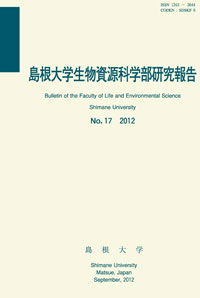島根大学生物資源科学部
ISSN:2435-0885(オンライン)
ISSN:1343-3644(冊子体)
なお、冊子体の刊行は23巻まで
ISSN:1343-3644(冊子体)
なお、冊子体の刊行は23巻まで

ダウンロード数 : ? 件
この文献の参照には次のURLをご利用ください : https://ir.lib.shimane-u.ac.jp/4387
島根大学生物資源科学部研究報告 6
2001-12-20 発行
海水産魚類の行動と肝臓の組織生化学的相関に関する比較形態学的研究
Comparative histochemical study of the livers of marine fishes in relation to their behavior
ファイル
内容記述(抄録等)
Background/Aims: Teleost livers are classified into two groups by histochemical properties in hepatocytes. One group contains the abundant glycogen, and the other contains the lipids in hepatocytes. The hepatic metabolism is in intimate connection of hepatic blood circulation and biliary pathway. We have studied on the correlation between behavior and histological components in livers by histochemical technique. Methods: Fifty species marine teleosts were collected from the local coasts of Shimane Peninsula and Oki Island. Livers were fixed by perfusion with paraformaldehyde, and observed by light microscopy in Osmium staining for lipid and PAS staining for glycogen. Sinusoids and vascular beds in blood capillaries were identified by immunohistochemistry for α-smooth muscle actin. Results: The lipid-rich livers had 13 fishes, the glycogen-rich livers had 33 fishes and both glycogen and lipid livers had 4 fishes. Hepatopancreas had 26 fishes. The glycogen-rich livers were well developed both the sinusoidal blood system and the bile ductal system. In contrast, the lipid-rich livers were poor developed of the sinusoidal capillaries. Conclusions: The present study indicates that there were differences in the pattern of hepatic histochemical components with different moving habits. A group of streamlined and well move fish has glycogen-rich liver, and a stocky body and poor move fish that live in the bottom of the sea, has lipid-rich liver.
肝臓は生体を維持する上で中心的な役割を担う臓器で,身体へのエネルギ−供給と様々な消化吸収物質の処理を行う等,多様な代謝機能を有している.また,身体を構成するタンパク質の合成,糖原および脂質の貯蔵等の有機物質代謝,鉄・カルシウム等の無機物質代謝,ビタミンおよびホルモン代謝,胆汁産生,解毒排出など,その働きは多岐に渡っている.
一般に動物の運動能力は生体におけるエネルギ−産生系で作られたエネルギ−量に左右されており,常に遊泳している魚種は,海底にじっとしている魚種に比べ,消費エネルギ−量は大きい.このエネルギ−供給源となる糖・脂質の貯蔵様式はそれぞれの魚種の食性に直接影響をうけている可能性が高く(1−3),エネルギ−産生系に関連した肝細胞内における貯蔵物質の生化学的組成の質・量的な変異が各魚種間で存在することが推察される.一方,この貯蔵物質の質・量的変異は,成長過程(4)および繁殖(5,6),越冬(7)など魚の生活サイクルの中でも変動することが知られているが,その変動の幅と肝臓機能との相関関係は未だよく解っていない.
脊椎動物の肝臓は,一般に糖代謝すなわちグリコ−ゲンを主体としたエネルギ−代謝系を構築しているが,魚類から哺乳類に至る動物の中には,積極的に糖質から脂質転換を行って,トリグリセリド(TG)の形で肝臓に貯蔵し,このTG がβ−酸化を経てTCA サイクルに取り込まれて,エネルギ−代謝系を構築しているグループが存在する(8,9).このTG を主体とした貯蔵様式をとっている脂肪性肝臓は,病態時(10−12)におけるいわゆる脂肪肝(Fatty change)または脂肪変性(Fatty regeneration)とは明らかに異なっており,その成立要因はほとんど解明されていない.
脂肪性肝臓を有する代表的な動物種は軟骨魚類,硬骨魚類の一部であり,両棲類幼生であるオタマジャクシをはじめ,ヒト胎児期のある一定時期においても脂肪性の肝臓を有している(13).特に魚類の肝臓は,組織学的に主としてTG が貯蔵された脂肪性肝臓とグリコ−ゲンの貯蔵を主体としたグリコ−ゲン肝を有する群に2分され,それぞれの代謝系は肝内微小循環系(14)および胆管系(15−18)と密接に連動して機能している.
今回,海水産硬骨魚類50種の肝臓を用いて,魚類の行動と肝臓の組織生化学的特性の相関関係を解明することを目的に,光学顕微鏡によって形態学的に観察した.焦点は,肝臓内の生化学的特性とコレステロ−ルおよび脂質代謝に関与した胆道系と微小血液循環系の形態学的特徴に注目し,魚の生態および行動に関連した若干の考察を加えたので報告する
肝臓は生体を維持する上で中心的な役割を担う臓器で,身体へのエネルギ−供給と様々な消化吸収物質の処理を行う等,多様な代謝機能を有している.また,身体を構成するタンパク質の合成,糖原および脂質の貯蔵等の有機物質代謝,鉄・カルシウム等の無機物質代謝,ビタミンおよびホルモン代謝,胆汁産生,解毒排出など,その働きは多岐に渡っている.
一般に動物の運動能力は生体におけるエネルギ−産生系で作られたエネルギ−量に左右されており,常に遊泳している魚種は,海底にじっとしている魚種に比べ,消費エネルギ−量は大きい.このエネルギ−供給源となる糖・脂質の貯蔵様式はそれぞれの魚種の食性に直接影響をうけている可能性が高く(1−3),エネルギ−産生系に関連した肝細胞内における貯蔵物質の生化学的組成の質・量的な変異が各魚種間で存在することが推察される.一方,この貯蔵物質の質・量的変異は,成長過程(4)および繁殖(5,6),越冬(7)など魚の生活サイクルの中でも変動することが知られているが,その変動の幅と肝臓機能との相関関係は未だよく解っていない.
脊椎動物の肝臓は,一般に糖代謝すなわちグリコ−ゲンを主体としたエネルギ−代謝系を構築しているが,魚類から哺乳類に至る動物の中には,積極的に糖質から脂質転換を行って,トリグリセリド(TG)の形で肝臓に貯蔵し,このTG がβ−酸化を経てTCA サイクルに取り込まれて,エネルギ−代謝系を構築しているグループが存在する(8,9).このTG を主体とした貯蔵様式をとっている脂肪性肝臓は,病態時(10−12)におけるいわゆる脂肪肝(Fatty change)または脂肪変性(Fatty regeneration)とは明らかに異なっており,その成立要因はほとんど解明されていない.
脂肪性肝臓を有する代表的な動物種は軟骨魚類,硬骨魚類の一部であり,両棲類幼生であるオタマジャクシをはじめ,ヒト胎児期のある一定時期においても脂肪性の肝臓を有している(13).特に魚類の肝臓は,組織学的に主としてTG が貯蔵された脂肪性肝臓とグリコ−ゲンの貯蔵を主体としたグリコ−ゲン肝を有する群に2分され,それぞれの代謝系は肝内微小循環系(14)および胆管系(15−18)と密接に連動して機能している.
今回,海水産硬骨魚類50種の肝臓を用いて,魚類の行動と肝臓の組織生化学的特性の相関関係を解明することを目的に,光学顕微鏡によって形態学的に観察した.焦点は,肝臓内の生化学的特性とコレステロ−ルおよび脂質代謝に関与した胆道系と微小血液循環系の形態学的特徴に注目し,魚の生態および行動に関連した若干の考察を加えたので報告する
About This Article
Other Article
PP. 23 - 29
